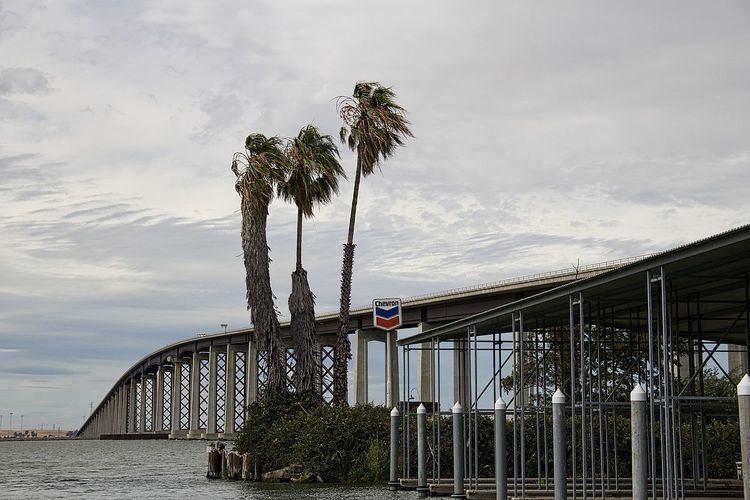Opened December 1978 Construction started 1976 | Owner Caltrans Clearance below 41 m Total length 2,897 m Bridge type Plate girder bridge | |
 | ||
Carries 2 lanes of SR 160, bicycles and pedestrians. Official name Senator John A. Nejedly Bridge Similar Benicia–Martinez Bridge, Carquinez Bridge, Dumbarton Bridge, Richmond–San Rafael Bridge, San Mateo–Hayward Bridge | ||
Antioch bridge
The Antioch Bridge (officially the Senator John A. Nejedly Bridge) is an automobile, bicycle, and pedestrian bridge that crosses the San Joaquin River linking Antioch, California with Sherman Island in southern Sacramento County, California, near the city of Isleton, California in the United States. Named after California State Senator John A. Nejedly, the bridge is signed as part of State Route 160. Unlike other toll bridges in California, the Antioch bridge has only a single lane of traffic for each direction.
Contents
- Antioch bridge
- Raw video officers prevent man from falling off antioch bridge
- History
- 1926 toll bridge
- State purchase
- Marine traffic collisions
- 1978 replacement bridge
- Tolls
- Animal incidents
- References
Raw video officers prevent man from falling off antioch bridge
History
The current bridge was completed and opened to traffic in December 1978. It is 1.8 miles (2.9 km) long.
1926 toll bridge
The original structure was completed in 1926 by the American Toll Bridge Company (Aven Hanford and Oscar Klatt), who went on to build the original span of the Carquinez Bridge. The bridge was opened on 1 January 1926 as a connecting link on the coast-to-coast Victory Highway. Hanford and Klatt, officials with the Rodeo-Vallejo Ferry Company, had organized the American Toll Bridge Company in 1923, which built the bridge at a cost of greater than US$2,000,000 (equivalent to $28,110,000 in 2016).
The Delta Bridge corporation had formed in December 1922, but did not complete a bridge at Antioch. Delta Bridge had received a franchise to build in June 1923.
The 1926 bridge featured two spans each 270 feet (82 m) long which provided a clearance of 70 feet (21 m) below when opened. The original lift span bridge was plagued with problems throughout its lifetime. Heavy traffic could cross it at no more than 15 miles per hour (24 km/h), and its narrow shipping channel led to collisions with freighters in 1958, 1963 and 1970.
State purchase
In 1937, Assemblyman Earl D. Desmond urged the California Toll Bridge Authority to acquire the Antioch Bridge. Desmond believed that by purchasing the bridge, tolls could be eliminated, which would spur economic growth. Director Frank W. Clark negotiated with the American Toll Bridge Company, and the state of California acquired ownership of both the Antioch and Carquinez Bridges at a cost of US$5,943,000 (equivalent to $101,600,000 in 2016) on September 16, 1940. Tolls were reduced immediately and further reduced in 1942.
Marine traffic collisions
The narrow ship channel afforded by the raised span led to marine traffic colliding with the bridge in 1958 (rammed by Kaimana), 1963 (rammed by Pasadena) and 1970 (rammed by Washington Bear).
The 1970 collision spurred efforts to build a replacement bridge. In that incident, the lift span was stuck in the raised position. The bridge tender could not leave the bridge and remained in the control house for 20 hours. Local firemen eventually made their way to him and brought him out. The bridge was closed for repairs for 5 months.
1978 replacement bridge
Sen. Nejedly authored Senate Bill 25, which later became Chapter 765 of the California Statutes of 1972, authorizing the issuance of revenue bonds to fund the construction of a replacement to the existing bridge. The bill cited the recent extended disruptions in bridge service from marine traffic damage as well as flooding of the approaches.
The high-level bridge opened in December 1978. Shortly before completion, the replacement bridge was named to honor Sen. Nejedly.
Tolls
When the original bridge opened in 1926, a toll was required for crossing. Ownership by the American Toll Bridge Company in 1940 set the tolls at $0.45 per car (equivalent to $7.69 in 2016) and an additional $0.05 per passenger (equivalent to $0.85 in 2016). Upon the state's acquisition of the bridge later that same year, tolls were promptly reduced to $0.30 per car (including up to four passengers), which is equivalent to $5.13 in 2016. By 1942, the toll was further decreased to $0.25, or $3.66 in 2016 dollars. Tolls were reinstated in 1978 following the completion of a new span.
Tolls are only collected from northbound traffic at the toll plaza on the south side of the bridge. Since July 2010, the toll rate for passenger cars is $5. During peak traffic hours, carpool vehicles carrying two or more people or motorcycles pay a discounted toll of $2.50. For vehicles with more than two axles, the toll rate is $5 per axle. Drivers may either pay by cash or use the FasTrak electronic toll collection device. There are currently three booths at the toll plaza, with the far left booth dedicated to FasTrak users only; the other two booths accept both cash and FasTrak.
Animal incidents
In 1965, three circus lions escaped from a truck passing over the Antioch Bridge. Two were quickly recaptured, but one drowned after falling into the river.
Humphrey the Whale was stranded near the Antioch Bridge in 1985.
